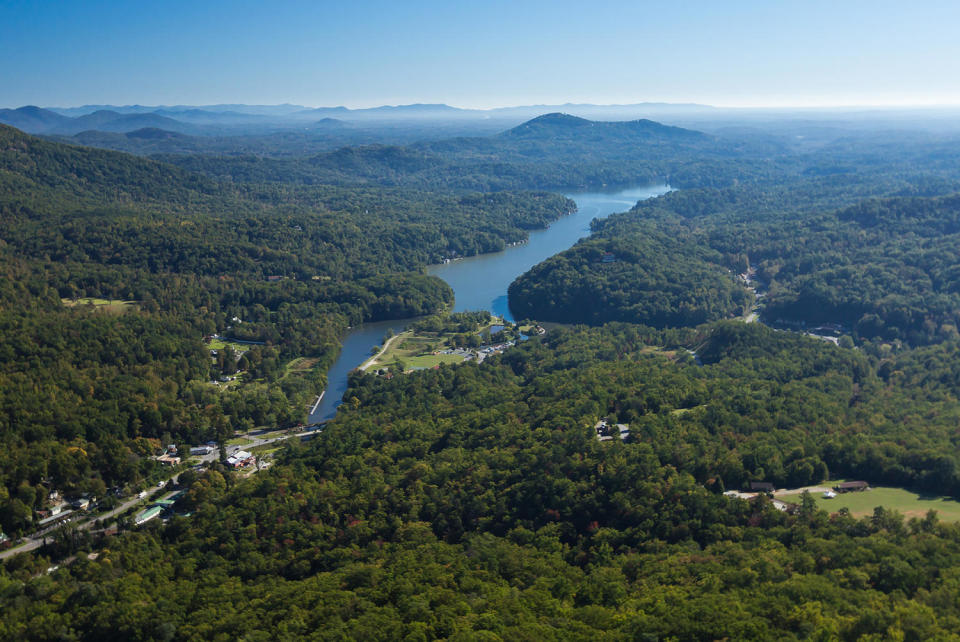The Lake Lure dam in western North Carolina overtopped on Friday after Hurricane Helene inundated the area, forcing evacuations and warnings from officials that the dam could fail.
Warnings about a second potential dam failure in the state — the Walters Dam, less than 100 miles from Lake Lure — also prompted concern in nearby Newport, Tennessee, as residents were asked to evacuate.
The Lake Lure dam, located about 25 miles east of Asheville, is still at imminent risk of failure and could flood downstream communities if that happens. Officials in South Carolina were warned that a failure could even impact towns there, according to the North Carolina Department of Environmental Quality.
“RESIDENTS BELOW THE LAKE LURE DAM NEED TO EVACUATE TO HIGHER GROUND IMMEDIATELY!!” the Rutherford County Emergency Management department wrote in a Facebook post at about 11 a.m. ET on Friday. “DAM FAILURE IMMINIENT!!”
As of 1:30 p.m., water was overtopping the dam, the emergency management agency said.
“Structural supports have been compromised but the Dam wall is currently holding,” the agency wrote on Facebook. “Emergency personnel are working with the structural engineers and are going house to house to ensure all citizens have been evacuated.”
The 124-foot tall hydroelectric dam, which is on the Broad River about 25 miles from Asheville, is operated by the town of Lake Lure, according to the National Inventory of Dams. Its maximum storage is 44,914 acre-feet, roughly equivalent to the volume of water in 22,500 Olympic swimming pools.


Olivia Stewman, the town manager of Lake Lure, said water was flowing around the dam on one side. Complicating the emergency response, she added, were blocked roads and downed trees throughout the area.
“Our dam engineer is on the way here. As soon as he can get here, he’s going to do a site assessment to determine the condition,” Stewman said. “Right now, our first responders and public safety services are working to do the most they can.”
The North Carolina Department of Environmental Quality similarly said on its website on Friday morning that the 480-foot long dam was eroding on one side. An update posted earlier in the day said that dam operators had lost power but were able to operate floodgates manually.
Southern Appalachia has been under deluge for several days, after a precursor storm brought rainfall that should be expected only once every 1,000 years to some areas. Then, the remnants of Hurricane Helene struck overnight and into Friday morning.
Jared Klein, a National Weather Service meteorologist, said the area near Lake Lure has been hammered by extreme rainfall over the past three days.
“You’re looking at 8 to 16 inches of rain in the area of the lake,” Klein said.
Lake Lure is considered a “high” hazard dam, according to the National Inventory of Dams — a classification that means failure or misoperation is likely to cause loss of life. The dam was described as in “fair” condition, as of a March 2023 inspection, the inventory said.
The town of Lake Lure has been trying to replace the aging dam. As of June 2023, it had received at least four grants from the Federal Emergency Management Agency that are designed to help rehabilitate or replace high-hazard dams. It also received $16.5 million for the project in 2022 from the state of North Carolina.
Earlier this year, the water level was lowered in the lake to replace key infrastructure, according to the city website. Over the summer, contractors were working on a project to install a reservoir drain, described as an “emergency preparedness feature” that would allow the lake to be lowered before a storm.
Meanwhile, confusion reigned in Newport, Tennessee, on Friday after local officials announced that the Walters Dam — also known as the Waterville Dam — had “suffered a catastrophic failure.”
However, Kristin Coulter, communications director for the Tennessee Emergency Management Agency, said later in the day that it was a false alarm, but that the town of Newport remained at risk.
“It’s not failing,” Coulter said. “Officials have asked residents to evacuate.”
United States Geological Survey stream data showed that the Pigeon River downstream of the dam was experiencing major flooding.
Valerie Patterson, a Duke Energy spokeswoman, said the dam and its floodgates were performing “as expected,” and that the company “has all gates open at the Waterville Dam and continues to pass water through the dam.”
The false statements about the dam’s failure appeared to come from Cocke County Mayor Rob Mathis, who later declared a state of emergency for the county, according to a Facebook post. The Tennessee Emergency Management Agency shared the warning from Mathis.
As a whole, America’s dams — more than 92,000 in total — are aging and many need costly restoration. Few dams were designed for today’s climate, with a warmer atmosphere that can hold and deliver more intense rain. Meanwhile, more people have moved into inundation zones below these dams.
In a report last year, the Association of State Dam Safety Officials estimated that it would take $157.5 billion to bring nonfederal U.S. dams up to par.
From 2013 to 2023, 283 dams in the U.S. experienced some kind of failure, according to data provided by the Association of State Dam Safety Officials and analyzed by NBC News this summer. Most dam failures didn’t ultimate cause public safety problems, but in 2019, a dam failure in Nebraska drowned a man whose home washed away.
This article was originally published on NBCNews.com
